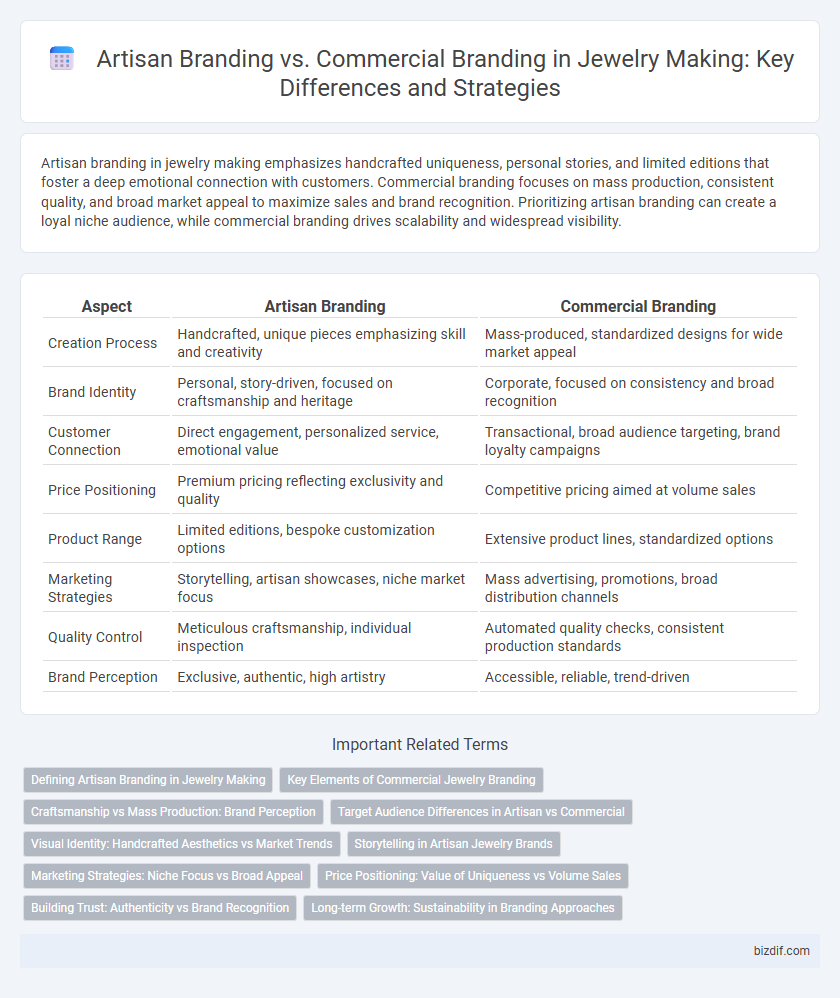Artisan branding in jewelry making emphasizes handcrafted uniqueness, personal stories, and limited editions that foster a deep emotional connection with customers. Commercial branding focuses on mass production, consistent quality, and broad market appeal to maximize sales and brand recognition. Prioritizing artisan branding can create a loyal niche audience, while commercial branding drives scalability and widespread visibility.
Table of Comparison
| Aspect | Artisan Branding | Commercial Branding |
|---|---|---|
| Creation Process | Handcrafted, unique pieces emphasizing skill and creativity | Mass-produced, standardized designs for wide market appeal |
| Brand Identity | Personal, story-driven, focused on craftsmanship and heritage | Corporate, focused on consistency and broad recognition |
| Customer Connection | Direct engagement, personalized service, emotional value | Transactional, broad audience targeting, brand loyalty campaigns |
| Price Positioning | Premium pricing reflecting exclusivity and quality | Competitive pricing aimed at volume sales |
| Product Range | Limited editions, bespoke customization options | Extensive product lines, standardized options |
| Marketing Strategies | Storytelling, artisan showcases, niche market focus | Mass advertising, promotions, broad distribution channels |
| Quality Control | Meticulous craftsmanship, individual inspection | Automated quality checks, consistent production standards |
| Brand Perception | Exclusive, authentic, high artistry | Accessible, reliable, trend-driven |
Defining Artisan Branding in Jewelry Making
Artisan branding in jewelry making emphasizes handcrafted uniqueness, intricate detailing, and the personal touch of the creator, differentiating each piece through craftsmanship and story. This approach highlights materials sourcing, traditional techniques, and limited production, fostering a deep connection between the artisan and the consumer. Unlike commercial branding, artisan brands prioritize originality and authenticity over mass appeal and uniformity.
Key Elements of Commercial Jewelry Branding
Commercial jewelry branding emphasizes consistency in logo design, color palette, and packaging to create instant recognition and trust among consumers. It leverages market research and competitor analysis to position products effectively, using targeted advertising and social media campaigns to boost visibility. Strong commercial brands also invest in customer loyalty programs and strategic partnerships, enhancing brand equity and driving sustained sales growth.
Craftsmanship vs Mass Production: Brand Perception
Artisan branding in jewelry emphasizes meticulous craftsmanship, unique designs, and the personal touch of the creator, enhancing brand perception as exclusive and high-quality. Commercial branding prioritizes mass production, consistency, and market scalability, often resulting in broader recognition but perceived lower uniqueness and quality. Consumer preference shifts toward artisan brands for authenticity and individuality, while commercial brands dominate for accessibility and trend-driven collections.
Target Audience Differences in Artisan vs Commercial
Artisan branding targets niche markets seeking unique, handcrafted jewelry with a personal story, appealing to customers valuing authenticity and craftsmanship. Commercial branding aims at mass markets, focusing on trends, affordability, and consistent quality to attract price-sensitive buyers seeking widespread availability. The distinct audience preferences influence design, marketing strategies, and brand messaging in each jewelry segment.
Visual Identity: Handcrafted Aesthetics vs Market Trends
Artisan branding in jewelry making emphasizes handcrafted aesthetics, showcasing unique, intricate details that highlight the maker's skill and creativity. Commercial branding prioritizes market trends, utilizing sleek, polished visuals and mass appeal to attract a broader audience. The visual identity of artisan jewelry often features natural textures and personalized elements, while commercial branding relies on consistent, trend-driven design for brand recognition.
Storytelling in Artisan Jewelry Brands
Artisan jewelry brands excel in storytelling by highlighting the unique craftsmanship, cultural heritage, and personal narratives behind each piece, creating an emotional connection with customers. Unlike commercial branding that emphasizes mass production and trend-driven designs, artisan branding leverages detailed stories about the maker's inspiration, techniques, and origin to differentiate their products. This authentic storytelling enhances brand loyalty and attracts discerning buyers who value originality and artistic expression in jewelry.
Marketing Strategies: Niche Focus vs Broad Appeal
Artisan branding in jewelry making emphasizes marketing strategies targeting niche audiences by highlighting handcrafted quality, unique designs, and cultural authenticity, appealing to consumers seeking exclusivity and personal connection. Commercial branding prioritizes broad appeal through mass production, standardized designs, and widespread retail distribution to attract a larger customer base with diverse preferences. Crafting marketing campaigns that leverage storytelling and community engagement enhances artisan brand loyalty, while commercial brands benefit from scalable advertising and competitive pricing to maximize market penetration.
Price Positioning: Value of Uniqueness vs Volume Sales
Artisan branding in jewelry making emphasizes the uniqueness and handcrafted quality of each piece, allowing for premium price positioning based on exclusivity and craftsmanship. Commercial branding focuses on volume sales, leveraging standardized designs and cost efficiencies to offer competitive prices appealing to a broader market. The value of uniqueness in artisan brands justifies higher price points, while commercial brands prioritize affordability and accessibility through economies of scale.
Building Trust: Authenticity vs Brand Recognition
Artisan branding in jewelry making builds trust through authenticity, emphasizing handcrafted techniques, unique designs, and personal stories that resonate with customers seeking genuine craftsmanship. Commercial branding relies on brand recognition, leveraging consistent marketing, widespread distribution, and established reputations to assure quality and reliability to a broader audience. Both approaches influence consumer trust, with artisan branding fostering emotional connections and commercial branding offering familiarity and proven value.
Long-term Growth: Sustainability in Branding Approaches
Artisan branding in jewelry making emphasizes authentic craftsmanship and unique designs, fostering strong emotional connections that support long-term customer loyalty and sustainable business growth. Commercial branding relies on mass production and broad market appeal, which can generate quick revenue but often lacks the personalized touch needed for enduring brand value. Prioritizing artisan branding techniques enhances sustainability by cultivating a dedicated customer base and preserving creative integrity over time.
Artisan branding vs Commercial branding Infographic

 bizdif.com
bizdif.com